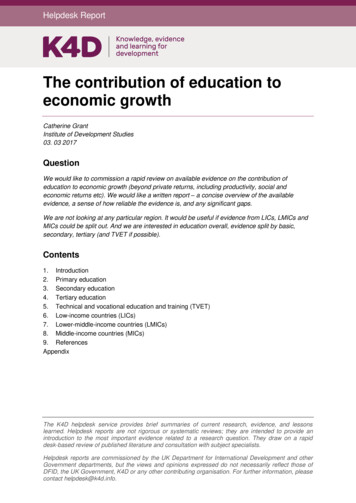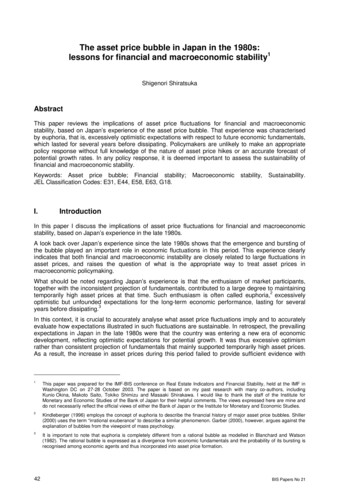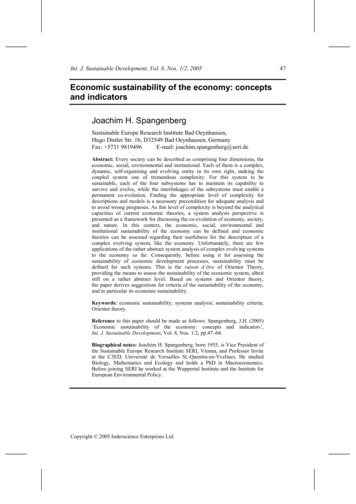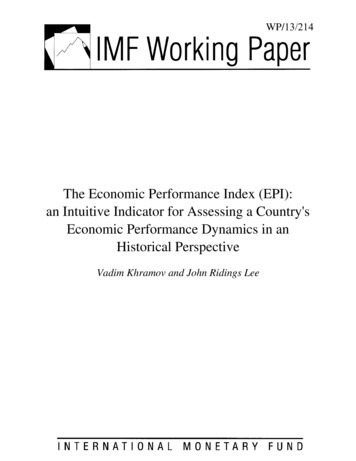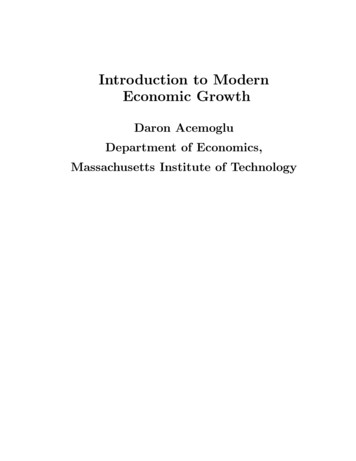
Transcription
Introduction to ModernEconomic GrowthDaron AcemogluDepartment of Economics,Massachusetts Institute of Technology
ContentsPrefacePart 1.xi1IntroductionChapter 1. Economic Growth and Economic Development:The Questions1.1. Cross-Country Income Differences1.2. Income and Welfare1.3. Economic Growth and Income Differences1.4. Origins of Today’s Income Differences and World Economic Growth1.5. Conditional Convergence1.6. Correlates of Economic Growth1.7. From Correlates to Fundamental Causes1.8. The Agenda1.9. References and Literature33811141923262932Chapter 2. The Solow Growth Model2.1. The Economic Environment of the Basic Solow Model2.2. The Solow Model in Discrete Time2.3. Transitional Dynamics in the Discrete Time Solow Model2.4. The Solow Model in Continuous Time2.5. Transitional Dynamics in the Continuous Time Solow Model2.6. Solow Model with Technological Progress2.7. Comparative Dynamics2.8. Taking Stock2.9. References and Literature2.10. Exercises3738486166717992949597Chapter 3. The Solow Model and the Data3.1. Growth Accounting3.2. Solow Model and Regression Analyses3.3. The Solow Model with Human Capital3.4. Solow Model and Cross-Country Income Differences: RegressionAnalyses3.5. Calibrating Productivity Differencesiii103103107117125135
Introduction to Modern Economic Growth3.6.3.7.3.8.3.9.Estimating Productivity DifferencesTaking StockReferences and LiteratureExercises141148150151Chapter 4. Fundamental Determinants of Differences in EconomicPerformance4.1. Proximate Versus Fundamental Causes4.2. Economies of Scale, Population, Technology and World Growth4.3. The Four Fundamental Causes4.4. The Effect of Institutions on Economic Growth4.5. What Types of Institutions?4.6. Disease and Development4.7. Political Economy of Institutions: First Thoughts4.8. Taking Stock4.9. References and Literature4.10. Exercises155155160163178199202206207208211Part 2.213Towards Neoclassical GrowthChapter 5. Foundations of Neoclassical Growth5.1. Preliminaries5.2. The Representative Household5.3. Infinite Planning Horizon5.4. The Representative Firm5.5. Problem Formulation5.6. Welfare Theorems5.7. Sequential Trading5.8. Optimal Growth in Discrete Time5.9. Optimal Growth in Continuous Time5.10. Taking Stock5.11. References and Literature5.12. apter 6. Dynamic Programming and Optimal Growth6.1. Brief Review of Dynamic Programming6.2. Dynamic Programming Theorems6.3. The Contraction Mapping Theorem and Applications*6.4. Proofs of the Main Dynamic Programming Theorems*6.5. Fundamentals of Dynamic Programming6.6. Optimal Growth in Discrete Time6.7. Competitive Equilibrium Growth6.8. Another Application of Dynamic Programming: Search for Ideasiv255256260266272280291297299
Introduction to Modern Economic Growth6.9. Taking Stock6.10. References and Literature6.11. Exercises305306307Chapter 7. Review of the Theory of Optimal Control7.1. Variational Arguments7.2. The Maximum Principle: A First Look7.3. Infinite-Horizon Optimal Control7.4. More on Transversality Conditions7.5. Discounted Infinite-Horizon Optimal Control7.6. A First Look at Optimal Growth in Continuous Time7.7. The q-Theory of Investment7.8. Taking Stock7.9. References and Literature7.10. Exercises313314324330342345351352359361363Part 3.371Neoclassical GrowthChapter 8. The Neoclassical Growth Model8.1. Preferences, Technology and Demographics8.2. Characterization of Equilibrium8.3. Optimal Growth8.4. Steady-State Equilibrium8.5. Transitional Dynamics8.6. Technological Change and the Canonical Neoclassical Model8.7. Comparative Dynamics8.8. The Role of Policy8.9. A Quantitative Evaluation8.10. Extensions8.11. Taking Stock8.12. References and Literature8.13. 8Chapter 9. Growth with Overlapping Generations4179.1. Problems of Infinity4189.2. The Baseline Overlapping Generations Model4219.3. The Canonical Overlapping Generations Model4279.4. Overaccumulation and Pareto Optimality of Competitive Equilibriumin the Overlapping Generations Model4299.5. Role of Social Security in Capital Accumulation4339.6. Overlapping Generations with Impure Altruism4369.7. Overlapping Generations with Perpetual Youth4419.8. Overlapping Generations in Continuous Time445v
Introduction to Modern Economic Growth9.9. Taking Stock9.10. References and Literature9.11. 10.6.10.7.10.8.10.9.10.10.10.11.10. Human Capital and Economic Growth463A Simple Separation Theorem463Schooling Investments and Returns to Education466The Ben Porath Model469Neoclassical Growth with Physical and Human Capital474Capital-Skill Complementarity in an Overlapping Generations Model 480Physical and Human Capital with Imperfect Labor Markets485Human Capital Externalities492Nelson-Phelps Model of Human Capital495Taking Stock498References and 4.11.5.11.6.11.7.11. First-Generation Models of Endogenous GrowthThe AK Model RevisitedThe AK Model with Physical and Human CapitalThe Two-Sector AK ModelGrowth with ExternalitiesTaking StockReferences and LiteratureExercisesPart 4.Endogenous Technological 12.3.12.4.12.5.12.6.12.7.12.8.12. Modeling Technological ChangeDifferent Conceptions of TechnologyScience, Profits and the Market SizeThe Value of Innovation in Partial EquilibriumThe Dixit-Stiglitz Model and “Aggregate Demand Externalities”Individual R&D Uncertainty and the Stock MarketTaking StockReferences and ter13.1.13.2.13.3.13.4.13. Expanding Variety ModelsThe Lab Equipment Model of Growth with Product VarietiesGrowth with Knowledge SpilloversGrowth without Scale EffectsGrowth with Expanding Product Varietiesvi571572586589593
Introduction to Modern Economic Growth13.5. Taking Stock13.6. References and Literature13.7. 14.6.14. Models of Competitive InnovationsThe Baseline Model of Competitive InnovationsA One-Sector Schumpeterian Growth ModelStep-by-Step Innovations*Taking StockReferences and . Directed Technological ChangeImportance of Biased Technological ChangeBasics and DefinitionsBaseline Model of Directed Technological ChangeDirected Technological Change with Knowledge SpilloversDirected Technological Change without Scale EffectsEndogenous Labor-Augmenting Technological ChangeOther ApplicationsTaking StockReferences and 98Part 5.Stochastic .16. Stochastic Dynamic ProgrammingDynamic Programming with ExpectationsPolicy Functions and TransitionsFew Technical Details*Applications of Stochastic Dynamic ProgrammingTaking StockReferences and 17.1.17.2.17.3.17.4.17.5.17.6.17. Neoclassical Growth Under UncertaintyThe Brock-Mirman ModelEquilibrium Growth under UncertaintyApplication: Real Business Cycle ModelsTaking StockReferences and LiteratureExercises709709710710710710710Chapter 18. Growth with Incomplete Marketsvii711
Introduction to Modern Economic Growth18.1.18.2.18.3.18.4.18.5.Part 6.The Bewley-Aiyagari ModelRisk, Diversification and GrowthTaking StockReferences and LiteratureExercisesTechnology Diffusion, Trade and .19.3.19.4.19.5.19.6.19.7.19.8.19.9.19.10.19. Diffusion of TechnologyImportance of Technology Adoption and DiffusionA Benchmark Model of Technology DiffusionHuman Capital and TechnologyTechnology Diffusion and Endogenous GrowthAppropriate Technology and Productivity DifferencesInappropriate TechnologiesEndogenous Technological Change and Appropriate TechnologyTaking StockReferences and 0. Trade, Technology and InterdependencesTrade, Specialization and the World Income DistributionTrade, Factor Price Equalization and Economic GrowthTrade, Technology Diffusion and the Product CycleLearning-by-Doing, Trade and GrowthTrade and Endogenous Technological ChangeTaking StockReferences and LiteratureExercises725725731732736736736736736Part 7.Economic Development and Economic .21.8.21. Structural Change and Economic GrowthNon-Balanced Growth: The Demand SideNon-Balanced Growth: The Supply SideStructural Change: MigrationStructural Change: Transformation of Productive RelationshipsTowards a Unified Theory of Development and GrowthTaking StockReferences and LiteratureExercisesChapter 22. Poverty Traps, Inequality and Financial Markets22.1. Multiple Equilibria From Aggregate Demand Externalitiesviii739739743743743743743743743745745
Introduction to Modern Economic .2.23.3.23.4.Human Capital Accumulation with Imperfect Capital MarketsIncome Inequality and Economic DevelopmentFinancial Development and Economic GrowthTaking StockReferences and LiteratureExercises75476176176176176123. Population Growth and the Demographic TransitionPatterns of Demographic ChangesPopulation and Growth: Different PerspectivesA Simple Model of Demographic TransitionExercises763763763763763Part 8.Political Economy of Growth765Chapter 24. Institutions and Growth24.1. The Impact of Institutions on Long-Run 79579880225. Modeling Non-Growth Enhancing InstitutionsBaseline ModelTechnology Adoption and HoldupInefficient Economic InstitutionsExercisesChapter 26. Modeling Political Institutions26.1. Understanding Endogenous Political Change26.2. Exercises803803815Part 9.817ConclusionsChapter 27. Putting It All Together: Mechanics and Causes of EconomicGrowth819Chapter 28. Areas of Future Research821Part 10.823Chapter29.1.29.2.29.3.Mathematical Appendix29. Review of Basic Set TheoryOpen, Closed, Convex and Compact SetsSequences, Subsequences and LimitsDistance, Norms and MetricsChapter 30. Functions of Several Variables30.1. Continuous Functions30.2. Convexity, Concavity, Quasi-Concavityix825825825825827827827
Introduction to Modern Economic .4.31.5.Taylor SeriesOptima and Constrained OptimaIntermediate and Mean Value TheoremsInverse and Implicit Function Theorems82782782782731. Review of Ordinary Differential EquationsReview of Complex NumbersEigenvalues and EigenvectorsLinear Differential EquationsSeparable Differential EquationsExistence and Uniqueness Theorems829829829829829829References (highly incomplete)831x
PrefaceThis book is intended to serve two purposes:(1) First and foremost, this is a book about economic growth and long-runeconomic development. The process of economic growth and the sourcesof differences in economic performance across nations are some of the mostinteresting, important and challenging areas in modern social science. Theprimary purpose of this book is to introduce graduate students to thesemajor questions and to the theoretical tools necessary for studying them.The book therefore strives to provide students with a strong backgroundin dynamic economic analysis, since only such a background will enable aserious study of economic growth and economic development. It also triesto provide a clear discussion of the broad empirical patterns and historicalprocesses underlying the current state of the world economy. This is motivated by my belief that to understand why some countries grow and somefail to do so, economists have to move beyond the mechanics of models andpose questions about the fundamental causes of economic growth.(2) In a somewhat different capacity, this book is also a graduate-level introduction to modern macroeconomics and dynamic economic analysis. It issometimes commented that, unlike basic microeconomic theory, there is nocore of current macroeconomic theory that is shared by all economists. Thisis not entirely true. While there is disagreement among macroeconomistsabout how to approach short-run macroeconomic phenomena and what theboundaries of macroeconomics should be, there is broad agreement aboutthe workhorse models of dynamic macroeconomic analysis. These includethe Solow growth model, the neoclassical growth model, the overlappinggenerations model and models of technological change and technology adoption. Since these are all models of economic growth, a thorough treatmentof modern economic growth can also provide (and perhaps should provide)an introduction to this core material of modern macroeconomics. Althoughthere are several good graduate-level macroeconomic textbooks, they typically spend relatively little time on the basic core material and do notdevelop the links between modern macroeconomic analysis and economicdynamics on the one hand and general equilibrium theory on the other.xi
Introduction to Modern Economic GrowthIn contrast, the current book does not cover any of the short-run topics in macroeconomics, but provides a thorough and rigorous introductionto what I view to be the core of macroeconomics. Therefore, the secondpurpose of the book is to provide a first graduate-level course in modernmacroeconomics.The topic selection is designed to strike a balance between the two purposesof the book. Chapters 1, 3 and 4 introduce many of the salient features of theprocess of economic growth and the sources of cross-country differences in economicperformance. Even though these chapters cannot do justice to the large literatureon economic growth empirics, they provide a sufficient background for students toappreciate the set of issues that are central to the study of economic growth andalso a platform for a further study of this large literature.Chapters 5-7 provide the conceptual and mathematical foundations of modernmacroeconomic analysis. Chapter 5 provides the microfoundations for much of therest of the book (and for much of modern macroeconomics), while Chapters 6 and7 provide a quick but relatively rigorous introduction to dynamic optimization.Most books on macroeconomics or economic growth use either continuous time ordiscrete time exclusively. I believe that a serious study of both economic growth andmodern macroeconomics requires the student (and the researcher) to be able to gobetween discrete and continuous time and choose whichever one is more convenientor appropriate for the set of questions at hand. Therefore, I have deviated from thisstandard practice and included both continuous time and discrete time materialthroughout the book.Chapters 2, 8, 9 and 10 introduce the basic workhorse models of modern macroeconomics and traditional economic growth, while Chapter 11 presents the first generation models of sustained (endogenous) economic growth. Chapters 12-15 covermodels of technological progress, which are an essential part of any modern economicgrowth course.Chapter 16 generalizes the tools introduced in Chapter 6 to stochastic environments. Using these tools, Chapter 17 presents the canonical stochastic growthmodel, which is the foundation of much of modern macroeconomics (though it isoften left out of economic growth courses). This chapter also includes a discussion of the canonical Real Business Cycle model. Chapter 18 covers another majorworkhorse model of modern macroeconomics, the neoclassical growth model withincomplete markets. As well as the famous Bewley-Aiyagari model, this chapter discusses a number of other approaches to modeling the interaction between incompletemarkets and economic growth.Chapters 19-23 cover a range of topics that are sometimes left out of economicgrowth textbooks. These include models of technology adoption, technology diffusion, appropriate technology, interaction between international trade and technology, structural change, poverty traps, inequality, and population growth. Thesexii
Introduction to Modern Economic Growthtopics are important for creating a bridge between the empirical patterns we observe in practice and the theory. Most traditional growth models consider a singleeconomy in isolation and often after it has already embarked upon a process ofsteady economic growth. A study of models that incorporate cross-country interdependences, structural change and the possibility of takeoffs will enable us to linkcore topics of development economics, such as structural change, poverty traps orthe demographic transition, to the theory of economic growth.Finally, Chapters 24-26 consider another topic often omitted from macroeconomics and economic growth textbooks; political economy. This is motivated bythe belief that the study of economic growth would be seriously hampered if wefailed to ask questions about the fundamental causes of why countries differ intheir economic performances. These questions invariably bring us to differences ineconomic policies and institutions across nations. Political economy enables us todevelop models to understand why economic policies and institutions differ acrosscountries and must therefore be an integral part of the study of economic growth.A few words on the philosophy and organization of the book might also beuseful for students and teachers. The underlying philosophy of the book is that allthe results that are stated should be proved or at least explained in detail. Thisimplies a somewhat different organization than existing books. Most textbooks ineconomics do not provide proofs for many of the results that are stated or invoked,and mathematical tools that are essential for the analysis are often taken for grantedor developed in appendices. In contrast, I have strived to provide simple proofs ofalmost all results stated in this book. It turns out that once unnecessary generalityis removed, most results can be stated and proved in a way that is easily accessibleto graduate students. In fact, I believe that even somewhat long proofs are mucheasier to understand than general statements made without proof, which leave thereader wondering about why these statements are true.I hope that the style I have chosen not only makes the book self-contained, butalso gives the students an opportunity to develop a thorough understanding of thematerial. In addition, I present the basic mathematical tools necessary for analysis within the main body of the text. My own experience suggests that a “linear”progression, where the necessary mathematical tools are introduced when needed,makes it easier for the students to follow and appreciate the material. Consequently,analysis of stability of dynamical systems, dynamic programming in discrete timeand optimal control in continuous time are all introduced within the main body ofthe text. This should both help the students appreciate the foundations of thetheory of economic growth and also provide them with an introduction to the maintools of dynamic economic analysis, which are increasingly used in every subdiscipline of economics. Throughout, when some material is technically more difficultand can be skipped without loss of continuity, it is clearly marked with a “*”. Thexiii
Introduction to Modern Economic Growthonly material that is left for the Mathematical Appendix are those that should be familiar to most graduate students. Therefore the Mathematical Appendix is includedmostly for reference and completeness.I have also included a large number of exercises. Students can only gain athorough understanding of the material by working through the exercises. Theexercises that are somewhat more difficult are also marked with a “*”.This book can be used in a number of different ways. First, it can be used in aone-quarter or one-semester course on economic growth. Such a course might startwith Chapters 1-4, then use Chapters 5-7 either for a thorough study or only forreference. Chapters 8-11 cover the traditional growth theory. Then Chapters 12-15can be used for endogenous growth theory. Depending on time and interest, anyselection of Chapters 18 and 19-26 can be used for the last part of such a course.Second, the book can be used for a one-quarter first-year graduate-level coursein macroeconomics. In this case, Chapter 1 is optional. Chapters 8, 3, 5-7, 8-11 and16-18 would be the core of such a course. The same material could also be coveredin a one-semester course, but in this case, it could be supplemented either withsome of the later chapters or with material from one of the leading graduate-levelmacroeconomic textbooks on short-run macroeconomics, fiscal policy, asset pricing,or other topics in dynamic macroeconomics.Third, the book can be used for an advanced (second-year) course in economicgrowth or economic development. An advanced course on growth or developmentcould use Chapters 1-11 as background and then focus on selected chapters fromChapters 19-26.Finally, since the book is self-contained, I also hope that it can be used forself-study.Acknowledgments. This book grew out of the first graduate-level introduction to macroeconomics course I have taught at MIT. Parts of the book have alsobeen taught as part of a second-year graduate macroeconomics course. I would liketo thank the students who have sat through these lectures and made commentsthat have improved the manuscript. I owe a special thanks to Monica MartinezBravo, Samuel Pienknagura, Lucia Tian Tian and especially Alp Simsek for outstanding research assistance, to Lauren Fahey for editorial suggestions, and to PolAntras, George-Marios Angeletos, Olivier Blanchard, Simon Johnson, Chad Jones,and James Robinson for suggestions on individual chapters.Please note that this is a very preliminary draft of the bookmanuscript. Comments are welcome.Version 1.1: April 2007xiv
Part 1Introduction
We start with a quick look at the stylized facts of economic growth and the mostbasic model of growth, the Solow growth model. The purpose is both to prepare usfor the analysis of more modern models of economic growth with forward-lookingbehavior, explicit capital accumulation and endogenous technological progress, andalso to give us a way of mapping the simplest model to data. We will also discuss differences between proximate and fundamental causes of economic growth andeconomic development.
CHAPTER 1Economic Growth and Economic Development:The Questions1.1. Cross-Country Income DifferencesThere are very large differences in income per capita and output per workeracross countries today. Countries at the top of the world income distribution aremore than thirty times as rich as those at the bottom. For example, in 2000, GDP(or income) per capita in the United States was over 33000. In contrast, income percapita is much lower in many other countries: less than 9000 in Mexico, less than 4000 in China, less than 2500 in India, and only about 700 in Nigeria, and muchmuch lower in some other sub-Saharan African countries such as Chad, Ethiopia,and Mali. These numbers are all at 1996 US dollars and are adjusted for purchasingpower party (PPP) to allow for differences in relative prices of different goods acrosscountries. The gap is larger when there is no PPP-adjustment (see below).We can catch a glimpse of these differences in Figure 1.1, which plots estimates ofthe distribution of PPP-adjusted GDP per capita across the available set of countriesin 1960, 1980 and 2000. The numbers refer to 1996 US dollars and are obtainedfrom the Penn World tables compiled by Summers and Heston, the standard sourceof data for post-war cross-country comparisons of income or worker per capita. Anumber of features are worth noting. First, the 1960 density shows that 15 yearsafter the end of World War II, most countries had income per capita less than 1500(in 1996 US dollars); the mode of the distribution is around 1250. The rightwardsshift of the distributions for 1980 and for 2000 shows the growth of average incomeper capita for the next 40 years. In 2000, the mode is still slightly above 3000, butnow there is another concentration of countries between 20,000 and 30,000. Thedensity estimate for the year 2000 shows the considerable inequality in income percapita today.3
Density of coutries.0001.00015.0002.00025Introduction to Modern Economic Growth.0000519601980020000100002000030000gdp per capita4000050000Figure 1.1. Estimates of the distribution of countries according toPPP-adjusted GDP per capita in 1960, 1980 and 2000.Part of the spreading out of the distribution in Figure 1.1 is because of theincrease in average incomes. It may therefore be more informative to look at thelogarithm of income per capita. It is more natural to look at the logarithm (log) ofvariables, such as income per capita, that grow over time, especially when growth isapproximately proportional (e.g., at about 2% per year for US GDP per capita; seeFigure 1.8). Figure 1.2 shows a similar pattern, but now the spreading-out is morelimited. This reflects the fact that while the absolute gap between rich and poorcountries has increased considerably between 1960 and 2000, the proportional gaphas increased much less. Nevertheless, it can be seen that the 2000 density for logGDP per capita is still more spread out than the 1960 density. In particular, bothfigures show that there has been a considerable increase in the density of relativelyrich countries, while many countries still remain quite poor. This last pattern issometimes referred to as the “stratification phenomenon”, corresponding to the fact4
.4Introduction to Modern Economic Growth1960.320000Density of coutries.1.21980678log gdp per capita91011Figure 1.2. Estimates of the distribution of countries according tolog GDP per capita (PPP-adjusted) in 1960, 1980 and 2000.that some of the middle-income countries of the 1960s have joined the ranks ofrelatively high-income countries, while others have maintained their middle-incomestatus or even experienced relative impoverishment.While Figures 1.1 and 1.2 show that there is somewhat greater inequality amongnations, an equally relevant concept might be inequality among individuals in theworld economy. Figures 1.1 and 1.2 are not directly informative on this, since theytreat each country identically irrespective of the size of their population. The alternative is presented in Figure 1.3, which shows the population-weighted distribution.In this case, countries such as China, India, the United States and Russia receivegreater weight because they have larger populations. The picture that emerges inthis case is quite different. In fact, the 2000 distribution looks less spread-out, withthinner left tail than the 1960 distribution. This reflects the fact that in 1960 Chinaand India were among the poorest nations, whereas their relatively rapid growth in5
Density of coutries weighted by population01.000e 092.000e 093.000e 09Introduction to Modern Economic Growth200019801960678log gdp per capita91011Figure 1.3. Estimates of the population-weighted distribution ofcountries according to log GDP per capita (PPP-adjusted) in 1960,1980 and 2000.the 1990s puts them into the middle-poor category by 2000. Chinese and Indiangrowth has therefore created a powerful force towards relative equalization of incomeper capita among the inhabitants of the globe.Figures 1.1, 1.2 and 1.3 look at the distribution of GDP per capita. While thismeasure is relevant for the welfare of the population, much of growth theory willfocus on the productive capacity of countries. Theory is therefore easier to map todata when we look at output per worker (GDP per worker). Moreover, as we willdiscuss in greater detail later, key sources of difference in economic performanceacross countries include national policies and institutions. This suggests that whenour interest is understanding the sources of differences in income and growth acrosscountries (as opposed to assessing welfare questions), the unweighted distributionmay be more relevant than the population-weighted distribution. Consequently,6
.4Introduction to Modern Economic Growth.31960Density of coutries.1.219800200068log gdp per worker1012Figure 1.4. Estimates of the distribution of countries according tolog GDP per worker (PPP-adjusted) in 1960, 1980 and 2000.Figure 1.4 looks at the unweighted distribution of countries according to (PPPadjusted) GDP per worker. Since internationally comparable data on employmentare not available for a large number of countries, “workers” here refer to the total economically active population (according to the definition of the InternationalLabour Organization). Figure 1.4 is very similar to Figure 1.2, and if anything,shows a bigger concentration of countries in the relatively rich tail by 2000, withthe poor tail remaining more or less the same as in Figure 1.2.Overall, Figures 1.1-1.4 document two important facts: first, there is a largeinequality in income per capita and income per worker across countries as shown bythe highly dispersed distributions. Second, there is a slight but noticeable increasein inequality across nations (though not necessarily across individuals in the worldeconomy).7
Introduction to Modern Economic Growth10USALUXlog consumption per capita FRAFINITANZL BELESPSWEGRCMUSISRPRTTTO CZEMACSVNKORARGURYSYCHUN OMCRI LJORSYRIDNBOLMDA AZE ECUKGZ JAMCHNNICCMRZWEPAKHNDCIVSENCOMBGDINDGMBGHA COGMOZBENKENNPLTJKSTP LSOUGAMDGRWATCDMLIMWIBFANERZMBTGOBDIGNBETH YEMTZA5NGA6789log gdp per capita 20001011Figure 1.5. The association between income per capita and consumption per capita in 2000.1.2. Income and WelfareShould we care about cross-country income differences? The answer is undoubtedly yes. High income levels reflect high standards of living. Economic growthmight, at least over some
Introduction to Modern Economic Growth 3.6. Estimating Productivity Differences 141 3.7. Taking Stock 148 3.8. References and Literature 150 3.9. Exercises 151 Chapter 4. Fundamental Determinants of Differences in Economic Performance 155 4.1. Proximate Versus Fundamental Causes 155 4.2.
